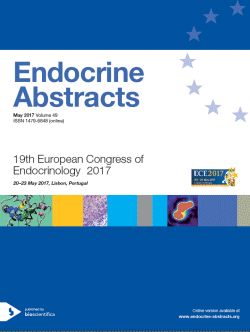
19th European Congress of Endocrinology
Lisbon,
Portugal
20 May 2017 - 23 May 2017
Eposter Presentations: Pituitary and Neuroendocrinology
Pituitary - Basic
ea0049ep924 | Pituitary - Basic | ECE2017
SSTR2 inhibits GH-secreting pituitary tumoral cells migration and invasion by increasing cofilin phosphorylation
Peverelli Erika , Giardino Elena , Treppiedi Donatella , Locatelli Marco , Lania Andrea G , Arosio Maura , Spada Anna , Mantovani Giovanna
ea0049ep925 | Pituitary - Basic | ECE2017
Anti-proliferative effect of sodium metaarsenite (KML001) on ACTH-secreting pituitary adenoma cells
Kim Dong Sun , Park Jung Hwan , Sung Yeon-Ah
ea0049ep926 | Pituitary - Basic | ECE2017
Angiogenesis-related proteins in pituitary adenomas
Karabid Ninelia Minaskan , Atkinson Michael , Pellegata Natalia
ea0049ep927 | Pituitary - Basic | ECE2017
Ketoconazole induces inhibition of cell viability and apoptosis in an ACTH-secreting tumour cell line model
Patalano Roberta , Pivonello Claudia , Solari Domenico , Vitulli Francesca , Iacuaniello Davide , Leo Monica De , Negri Mariarosaria , Provvisiero Donatella Paola , Cavallo Luigi Maria , Cappabianca Paolo , Colpo Annamaria , Pivonello Rosario
ea0049ep928 | Pituitary - Basic | ECE2017
GPR101 orphan receptor: a novel cause of growth hormone deregulation
Abboud Dayana , Daly Adrian , Dupuis Nadine , Laschet Celine , Pirotte Bernard , Beckers Albert , Hanson Julien
ea0049ep929 | Pituitary - Basic | ECE2017
Potential role of biguanides and statins in the treatment of pituitary adenomas
Vazquez-Borrego Mari C. , Fuentes-Fayos Antonio C , Ibanez-Costa Alejandro , Blanco-Acevedo Cristobal , Venegas-Moreno Eva , Galvez-Moreno Maria A , Soto-Moreno Alfonso , Castano Justo P. , Luque Raul M.
ea0049ep931 | Pituitary - Basic | ECE2017
Whole exome sequencing of two non-secreting pituitary adenoma tumors from the same patient
Rovite Vita , Peculis Raitis , Balcere Inga , Stukens Janis , Konrade Ilze , Valtere Andra , Nazarovs Jurijs , Caune Olivija , Pirags Valdis , Klovins Janis
ea0049ep932 | Pituitary - Basic | ECE2017
Ubiquitin specific peptidase 8 (USP8) in human corticotroph pituitary tumors- possible targets and mode of action
Weigand Isabel , Knobloch Lisanne , Vanselow Jens T. , Flitsch Jorg , Monoranu Carmelia M , Saeger Wolfgang , Hagel Christian , Herterich Sabine , Ronchi Cristina , Schlosser Andreas , Fassnacht Martin , Deutschbein Timo , Sbiera Silviu
ea0049ep933 | Pituitary - Basic | ECE2017
Acquired temozolomide resistance in ACTH-secreting pituitary tumour cells
Silva Ticiana , Van Koetsveld Peter , Dogan Fadime , Feelders Richard , Hofland Leo
ea0049ep934 | Pituitary - Basic | ECE2017
PP4C restrains dopamine D2 receptor expression in rat pituitary MMQ cells
ea0049ep935 | Pituitary - Basic | ECE2017
HER2, EGFR and PDGF family members as potential prognostic markers and their therapeutic implications
Corlan Ana Silvia , Cimpean Anca , Raica Marius , Melnic Eugen , Ceausu Raluca Amalia
ea0049ep936 | Pituitary - Basic | ECE2017
Carbohydrate metabolism disturbances at different types of acromegaly treatment
Dreval' Alexandr , Vinogradova Anna



